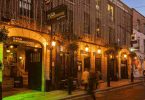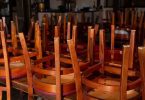Old vs New at The Parting Glass
Dramatically described by The Parting Glass’s Dom Brice as the ‘Clash of the Titans’ the usual format of one-and-only-one regional tasting is forsworn in favour of a comparing and contrasting of similar grape but from the Old World vs the New World in the wines on offer.
Such comparisons help highlight just what a difference climate and winemaking technique (not to mention terroir) can have over the finished product.
Our guides for the evening are Paul Savage and Hugh Murray, Sales Development Executive and Sales Director respectively for Classic Drinks, who take us through a pretty impressive comparative tasting which opens with the Sauvigon Blanc varietal, one of the most widely planted grapes in France.
As Dom explains, names as far apart as Marlborough, Sancerre and Fume Blanc appear when discussing this grape but it’s wide-ranging success has also limited its appeal.
“There’s more to it than intense gooseberries. It ages very well and will even take a little time in oak, but tonight we’re looking at the lighter, fruitier side,” he explains.
“Poor man’s Sancerre”, a Touraine from the Loire Valley in the form of a 2009 Bougrier Sauvignon, is put up against a Rabbit Island Sauv B from New Zealand.
What appears straight off the tongue is that the Old Worlder lacks the racy acidity of the New. Instead, it brings with it a typical latent subtlety that’s nowhere to be found in the Rabbit Island.
Dom explains that Touraine is a well-known wine on the lists of restaurants and is often seen as a Monday/Tuesday/Wednesday wine – enjoyable and easy drinking.
For the Chardonnay toe-to-toe, we taste Domaine de Rochebin Macon Villages alongside Roundhill Oak Free Chardonnay from California.
“Unfortunately Chardonnay suffers from an image problem,” confirms Dom, “It conjures up flavours of heavily-oaked New World wines, hence the appearance of ‘ABC’ – ‘Anything But Chardonnay’ – but this overlooks the sterling work Chardonnay does in almost all White Burgundy; it’s also the only white grape used in Champagne production. Hopefully these two wines exemplify fruity Chardonnay done well”.
While the Rochebin Macon Villages is a step up from the cheaper label Macon Blanc, it would naturally aspire to the cachet of Macon Lugny which itself aspires to Pouilly Fuisse, the best-known wine in the Maconnais region.
The Californian Roundhill Oak Free Chardonnay wins the day on the palates of the majority present but all the while, I’m becoming aware of the subtlety of the Old World when comparing it to the brashness of the New – and not just in length – and I believe Dom when he says of the French wine, “If you’re looking for a Chablis substitute for around €10, this is your wine”.
The Rieslings chosen for the next round of the tasting spat consist of a traditional Villa Huesgen Riesling from the Mosel set against Western Australia’s Ferngrove Cossacks Riesling.
“Regarded by most as being synonymous with the long-necked bottles of German off-dry wines, Riesling grapes have a high glycerine content which produces a wine perfect for aging,” explains Dom, “Added to this, it’s ability to produce superb sweet wines as well as some exceptional dry wines and it highlights the fact that Riesling is a highly-versatile and underrated grape varietal. Here we have two distinct fruit styles”.
He goes on to explain the particular vineyard characteristics of the Mosel region.
“This region is unusual as the vineyards are based on vertical slopes in the Mosel Valley in Northern Germany, with the soil being rocky, minerally and flint-based. The people who harvest the grapes go to great lengths here to get at them, having to rely on a pulley system to be able to reach the vines and pick the grapes. Being based on these extreme slopes, enables the vineyards to gain the maximum sun, rain and drainage available.”
But New World Ferngrove Cossaks Riesling didn’t come down with the last vintage. Ferngrove’s winemaker Kim Horton was 2007 Winemaker of the Year. Despite this lofty accolade, it’s the Old World that wins out amongst this assembly as Hugh Murray points out that a good Riesling will age indefinitely.
Moving onto the reds and the Pinot Noir grape, Dom tells us that Pinot is “the most prominent grape varietal in Red Burgundy production. It is also a key constituent of Champagne; in the right conditions and hands, Pinot Noir can produce the richest, velvet smooth finessed wines in the world. Add to this the range of fruit flavours that different climates and techniques can extract from their grape and it’s easy to see why it’s becoming more widely planted”.
But of course it’s not that simple. Hugh’s quick to point out that Pinot is a difficult grape to grow and when it does, there can be mixed results. He colourfully likens it to “the child at the back of the class with buck teeth and spots that can grow up to be either a maths genius or a mass murderer – outstanding or truly awful….”
When it’s good though, it’s very very good, crying out to be a Christmas dinner ‘must-have’ alongside Chardonnay.
The two labels chosen for this comparison are Lupe Cholet Comte de Lupe Pinot Noir originating in Burgundy’s Cote d’Or and Cote Challonaise and a Chilean 2009 Veramonte Reserva Pinot Noir. In this case I look to the Veramonte which seems to have released more than the Lupe Cholet ever had in the first place despite being told that the Veramonte could do with another five years in the bottle.
The final tasting of the night comprises the Syrah & Syrah Blends.
“Best-known as Shiraz in Australia (this name demonstrates its Eastern roots – Shiraz is the provincial capital in Iran), Syrah suffers in a similar way to Chardonnay. Again Syrah can produce hugely different styles of wine, oaked heavily alcoholic Australian or restrained fruit-driven wines from Southern France”. The tasting tests a 2009 Olivier Ravoir Crozes Hermitage from the Northern Rhone against a Turkey Flat Shiraz Grenach Mourvedre from South Australia.
If you’re prepared to leave the Olivier Ravoir alone for a while after pouring to let it “get it’s head together” as Hugh puts it, the results can be somewhat enhanced, he promises. He proves right and should we be trying this at home, we’re advised to decant and leave for a couple of hours rather than knocking it back immediate-like.
While the Crozes Hermitage is 100 per cent Syrah, the South Australian consists of Shiraz (55 per cent), Granache (35 per cent) and Mourvedre (10 per cent) – hardly a fair comparison, admittedly, but by this stage palates are jaded anyway and we’re after more pleasantness than judicial ability…
Professional tastings by their nature never tend to present a direct comparison of Old and New Worlds in this way and The Parting Glass scored a direct hit with this customer. More power to Dom, Catherine and The Parting Glass for that….








